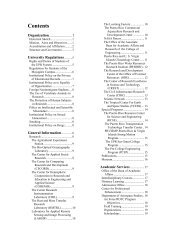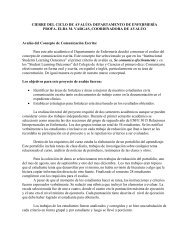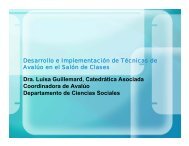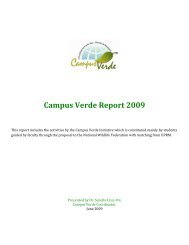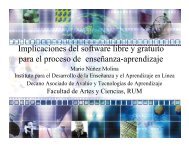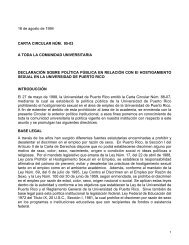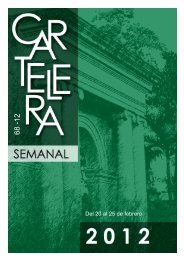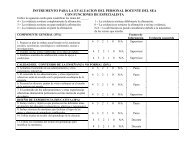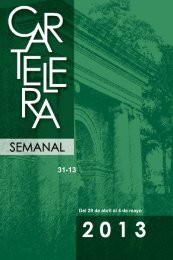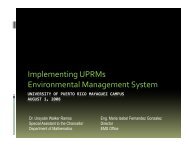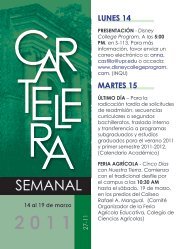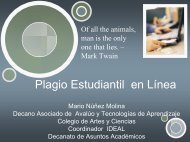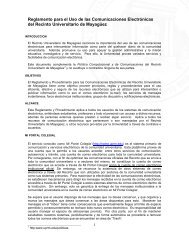Graduate Catalogue - UPRM
Graduate Catalogue - UPRM
Graduate Catalogue - UPRM
Create successful ePaper yourself
Turn your PDF publications into a flip-book with our unique Google optimized e-Paper software.
12 Research<br />
education and communication technologies for<br />
education.<br />
CECI also publishes Hermes, a newsletter which<br />
provides information regarding CECI’s<br />
activities, and includes brief articles describing<br />
specific Internet and education related tools and<br />
software. It also serves the purpose of<br />
identifying and sharing with the faculty useful<br />
resources available on the World Wide Web.<br />
Although Hermes is published in print, it is also<br />
available at www.uprm.edu/ceci/hermes.htm.<br />
Center Research Instrumentation Laboratory<br />
CRIL was founded in 1982 by the Department<br />
of Chemistry it contains sophisticated<br />
instrumentation for inorganic, organic and<br />
environmental analysis. The staff includes a<br />
director and two instrumentation assistants.<br />
Available instrumentation include a 500 MHz<br />
Bruker and 300 MHz Varian NMR, a System<br />
2000 FT-IR coupled to a Gas Chromatograph<br />
and equipped with near and mid IR detectors, a<br />
Hewlett Packard Gas Chromatography/Mass<br />
Spectrometry system, a Perkin Elmer and Varian<br />
Atomic Absorption Spectrophotometers<br />
equipped with flame, cold vapor and graphite<br />
furnaces; a Leeman Labs Inductive Coupled<br />
Plasma-Optical Emission Spectrometry system, a<br />
Dionex Ion Chromatograph equipped with<br />
conductivity detector; and a Finnigan<br />
GC/MS/MS equipped with direct insertion<br />
probe, electron impact and chemical ionization<br />
sources. The CRIL staff provides services to<br />
undergraduate and graduate courses, research<br />
groups of the Chemistry Department, as well as<br />
other academic departments, the community,<br />
government agencies, and local industry.<br />
Heat and Mass Transfer Research<br />
Laboratory<br />
HMTR comprises research facilities dedicated to<br />
basic and applied theoretical and experimental<br />
research in heat and mass transfer phenomena.<br />
Administered by the Mechanical Engineering<br />
Department of the University of Puerto Rico at<br />
Mayagüez it is located on the first floor of the<br />
Luchetti Building.<br />
Facilities associated with HMTRL include<br />
several Pentium-based personal computers and<br />
silicon graphics CAD work stations, a solar<br />
collector testing facility, spray cooling<br />
experimental facilities, spray forming<br />
experimental facilities, and extensive<br />
instrumentation to measure flow, humidity,<br />
pressure, and temperature. Research in<br />
environmental flows, heat transfer in<br />
manufacturing of electronics components, metal<br />
sprays, solar energy, spray cooling, and twophase<br />
flows is currently being conducted at<br />
HMTRL. External agencies and companies<br />
sponsor most research projects.<br />
Laboratory for Applied Remote Sensing and<br />
Image Processing<br />
LARSIP is a multidisciplinary laboratory<br />
located within the Department of Electrical and<br />
Computer Engineering at <strong>UPRM</strong> dedicated to<br />
research and implementation of remote sensing,<br />
and to the development of signal and image<br />
processing, geographical information systems<br />
(GIS), and emergency response system and<br />
Global Positioning System (GPS) technologies.<br />
Additional services such as scanning, slide<br />
making, color plotting, and accessing aerial color<br />
and infrared photographs provided by NASA<br />
continue to be in high demand. The Space<br />
Information Laboratory receives, processes, and<br />
distributes images of the Caribbean and Northern<br />
Amazon regions for the purpose of investigation,<br />
planning, proposing, deciding upon and<br />
implementing studies of the infrastructure of the<br />
entire Caribbean community of nations and a<br />
large portion of the Amazon region.<br />
The National Science Foundation (NSF),<br />
National Aeronautics and Space Administration<br />
(NASA), and the American Telephone and<br />
Telegraph Corporation (AT&T) provided initial<br />
funding for LARSIP and its research projects.<br />
Currently, LARSIP receives funding from<br />
NASA University Research Centers Program,<br />
(NASA-URC), RAYTHEON Corporation,<br />
Economic Development Administration of the<br />
Government of Puerto Rico (FOMENTO), and<br />
UPR through the Tropical Center for Earth and<br />
Space Studies (TCESS) established in 1995.<br />
TCESS complements and enhances LARSIP.<br />
Both LARSIP and TCESS function as training<br />
centers in a bilingual (Spanish and English)<br />
environment for current and future scientists and<br />
engineers of the Caribbean region and the South<br />
and Central Americas. The training centers are<br />
multidisciplinary in scope, serving Mayagüez<br />
and other UPR campuses. Universities and<br />
institutions in other countries are encouraged to<br />
12<br />
<strong>Graduate</strong> <strong>Catalogue</strong> 2010-2011



